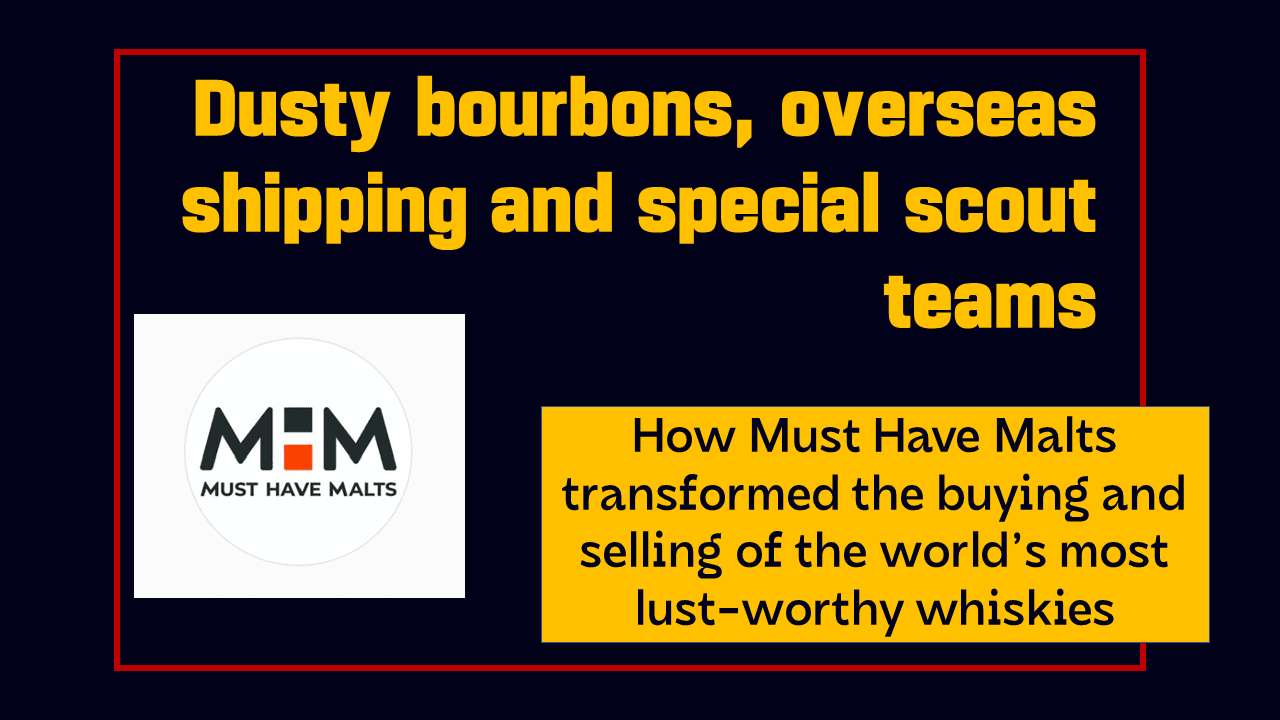| Don't like ads? | No ads |
If you’re looking for a rare bottle of whiskey, you have basically three options. The first way is to be a preferred customer with a store in your area. But in order to get that status (and the allocated and desirable bottles that come along with it), you usually have to spend thousands of dollars and make frequent trips every month to build a connection. The second way to get rare bottles is to explore the seedy world of the “secondary market.”
These secondary sales groups are hard to find, harder to get into and since they’re technically illegal, have no protections against scammers. The secondary markets establishes the actual value of rare bottles since distilleries can’t or won’t.
Buying on a secondary market is not the most expensive option though, that’s reserved for the third way to find rare bottles which is to find a local store that has the bottles you want in stock. The issue with that is if a store has rare bottles in stock and setting on a shelf, there is a 100% chance the price is going to be even higher than the secondary market.
Online Whiskey Retailers in Europe
Over the past couple years, a fourth option has appeared. Online retailers based in Europe have begun to sell bottles of rare American Whiskey at competitive prices. Initially, buyers were lured into these stores because they carried Blanton’s varieties that you couldn’t get in the United States.
But as consumer’s knowledge of bourbon grew, many buyers realized that there were far better bottles than just Blanton’s. “Dusty” bourbons became popular and more sought after.
Buying whiskey overseas had two advantages. The first one was that it came with a guarantee that if you didn’t get your product, there was something you could do about it (credit card dispute). The second was that thanks to the exchange rates that are constantly in flux, you could sometimes get a great deal on a bottle that would cost much more in the US.
Must Have Malts streamlines the overseas buying experience
One of these types of stores is Must Have Malts based in the Netherlands. I first found out about MHM 18 months ago when I started to get into Scotch. It occurred to me just how much more they had to offer though. In a short period of time, I was had bottles coming to my door from Independent Bottlers that aren’t available in the United States as well as some more rare bottles that I couldn’t find on the shelf here (like my bottle of 2019 Four Roses Small Batch Limited Edition).
Best of all it was shipped to my door in an expertly packaged box and arrived within 7 days. Shipping terms have changed since then due to ever-changing customs procedures but it’s still good to know that MHM stands behind all of their bottles arriving safely and as quickly as they can.
After a while, one of the whiskey groups I’m in began to realize we were all buying a lot of our bottles from MHM over the past year. The secret was out but the constantly changing inventory still draws you in to check regularly for what new goodies they had. This led to the most important question: “where do all of these great bottles come from?!”
Where in the world did they find this rare bourbon?
Thanks to Steve Cox, a spirits enthusiast and one of my friends in the Neat Drinker’s Association, he facilitated a Zoom call with Pim Wijers of Must Have Malts. Pim is one of three co-owners but most importantly he’s the face and voice of the brand. The other two owners are some of his best friends who he met during his college years. ‘
During these formative years, Pim and his friends developed a taste for great whiskey. We wanted to pick his brain on everything from his tastes in whiskey to finding out how exactly he comes across all of these awesome bottles. Steve decided that it would be more fun and interactive if he we all sat down as a group and shared some whiskey while picking his brain.
Steve sent a sampler box of dusty bourbons and whiskies to Pim and the rest of the NDA members as an ice breaker towards a broader whiskey discussion. The date was set and we all gathered around to finally meet the man that held the key to all of these great whiskies.

As soon as the Zoom started, we were greeted with a man who looked a bit like a young Seth Rogan. It was night time in the Netherlands and about mid-afternoon in the United States. The time zone difference made it hard to come up with a good compromise for when we’d be able to talk and share some drinks, but we made it work out.
We started out by introducing ourselves and making small talk while we poured our first sample which was a 2015 High West Rendezvous Rye. While not technically a “dusty” it is a bottle that is still able to be found on shelves and contains a unique 16-year-old Barton Rye Whiskey. The goal was to drink through progressively older whiskey as we talked.
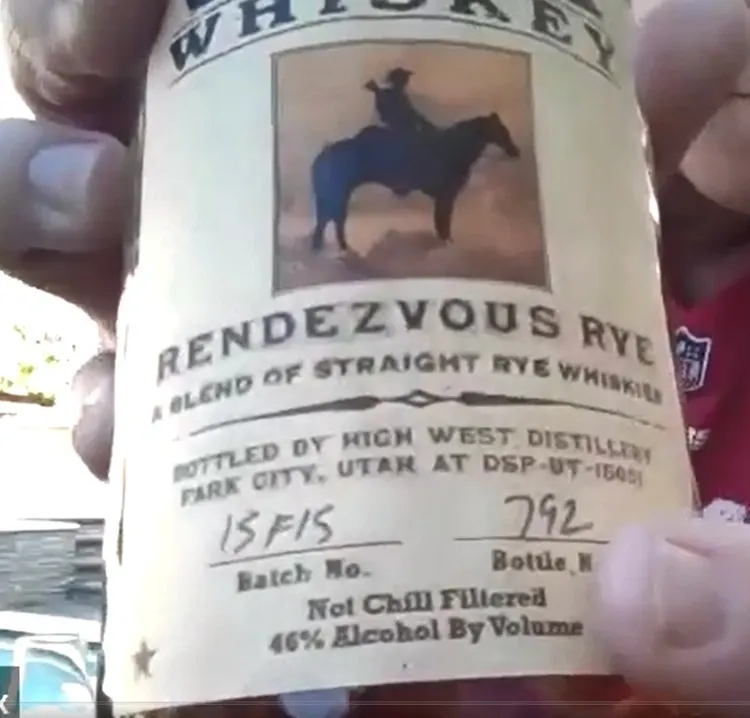
As we began our tasting, Pim reflected on his affinity for dusties and how it’s difficult to find them bottled at much over 90 proof. We talked about how the low proof of dusties makes it easier to pick out the full gamut of profile notes rather than battling through the heat of higher proofed whiskies.
Pim admits that for bottles like Booker’s, he likes to add a bit of water to it. He noted how American Bourbon seems to carry much more heat than Scotch at comparative proof points. Many in our group also admitted to enjoying our whiskies at lower proofs these days.
This seems to be a common trend among seasoned enthusiasts. Pim admitted that he enjoyed the Rendezvous Rye and that it didn’t have as much spicy influence as he thought it would.
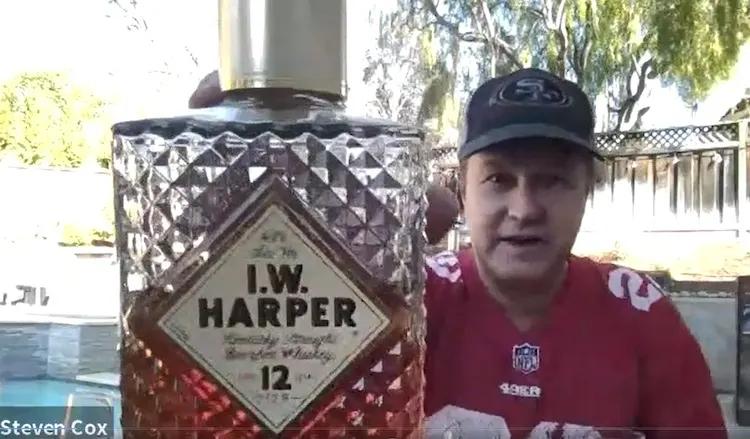
Moving on, the next bottle Steve had picked for us was a 12-year-old bottle of IW Harper. This bottle was purchased from MHM and carries markings that show it’s a Japanese export. Steve asked Pim how his store in Europe came across a bottle from Japan.
The answer was surprising: MHM employs a team of savvy experts that search for rare bottles outside of the Netherlands. This team’s main goal is to find the best whiskies out there and ship them back to MHM’s warehouse. This is not an illegal way of doing business for their company and is quite smart for reasons that I will get into as the story progresses.
As we drank through the IW Harper, Steve explained to us the finer points of why this tastes familiar to those of us who have lots of experience with older bourbons. The bottle was distilled in 1993 and bottled in 2005 and is actually from the same batch of bourbon that makes up the Orphan Barrel Rhetoric series.
They were all part of a giant batch that was distilled at the New Bernheim distillery shortly after it was bought by United Distillers in 1992. The bottle has a trademark look to it that all other highly aged IW Harper bottles have carried throughout the years.
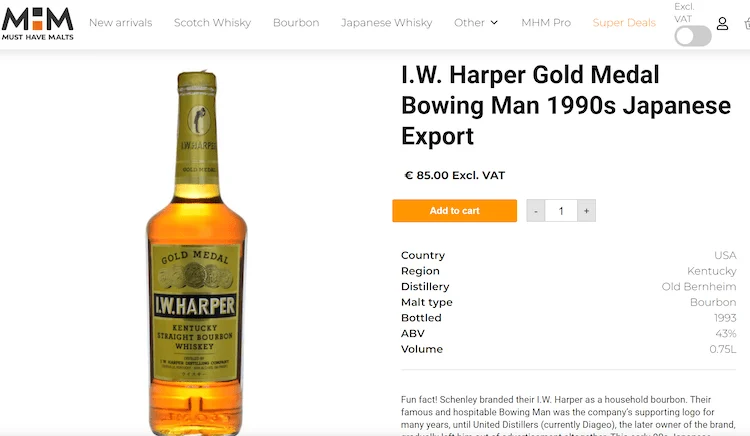
Pim and Steve began to talk about the brand IW Harper because it is frequently found in European stores to this day. IW Harper as a brand had spent a significant amount of time away from American shores due to lackluster domestic bourbon sales at the time.
It was the Japanese market that kept it afloat which is why so many of these bottles can be found there to this day. These days, Heaven Hill continues to distill the bourbon found inside of modern IW Harper bottles using the same mash bill that United Distillers had used. We all agreed that the new stuff’s quality and taste seems to have taken a hit.
The conversation led Steve to show us another bottle of IW Harper that is nicknamed the “Bowing Man.” It looks more like your standard whiskey bottle shape but is adorned with a gold neck label that has the image of a man with a top hat in a “bowing” stance.
Pim recounted a story his team learned about the bowing man image that was used in a lot of 1980’s bottlings and how it was supposed to mimic the “Striding Man” found on Johnnie Walker labels. IW Harper decided to get rid of it sometime in the late 90s or early 2000s probably out of fear of a trademark lawsuit.
While we’re on the topic of export bourbon, Pim casually drops the frequency of just how much dusty bourbon his team has found in Germany and Italy. Chris, another member of the NDA, asks why that is. Pim replied that he’s not exactly sure but he thinks that bourbon was highly sought after in Italy due to all the Spaghetti Westerns that were made there in the 70s and 80s.
He said that Italians who watched these believed that if they wanted to be like American cowboys, that they should drink bourbon too. Germany’s place on the front lines of the Cold War, coupled with American cultural influence, may be the reason for their infatuation with bourbon as well.
Identifying Dusty bottles before putting them up for sale
At this point, we began to discuss how exactly Pim’s team goes about dating each bottle before they put it up for sale on the MHM website. He answers that the data on the label, numbers imprinted on the glass itself or the tax strips are the most common methods.
In most of these countries, the bourbon arrived wearing an American tax strip which then had the European country’s tax strip placed over top of it.
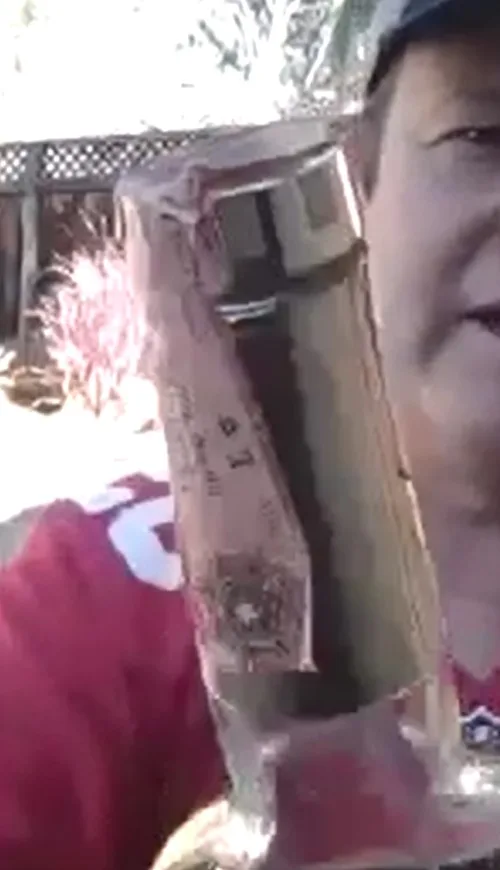
That means that if you could not determine the date a particular bottle was produced, you may be able to peel back that country’s tax strip and view the American one underneath.
According to Pim, there were even special tags that bottles of bourbon wore in Germany up until 1979 that said “Ausländisches Erzeugnis” which loosely translates to “Foreign Product.” After that year, this tag was no longer required to be placed on each imported bottle.
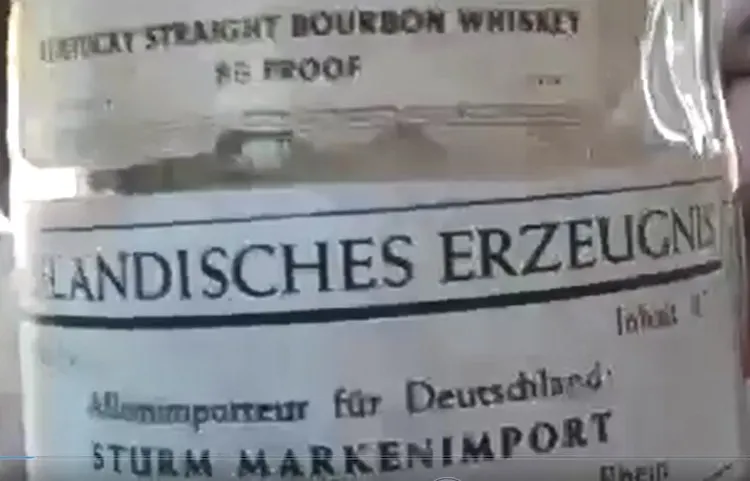
Looking over the bottles available on the MHM website, it becomes abundantly clear how important the team views properly dating each bottle they sell. We asked Pim how long his team spends researching bottle date information and his answer was that it varies. Most of the time they are able to narrow it down withing 5 to 10 minutes.
Any longer than that and he will reach out to his “secret American contact” who is their go-to specialist for all things dusty whiskey. He usually responds immediately to help them out no matter what time of the day it is.
Other times, if the bottle is one of the lower-priced ones in their inventory, they’ll just try to get a general timeframe of when it was bottled. You’ll tend to see more vague descriptions like “1980’s” or “1996-1999” for bottles that are less prestigious and cheaper in price.
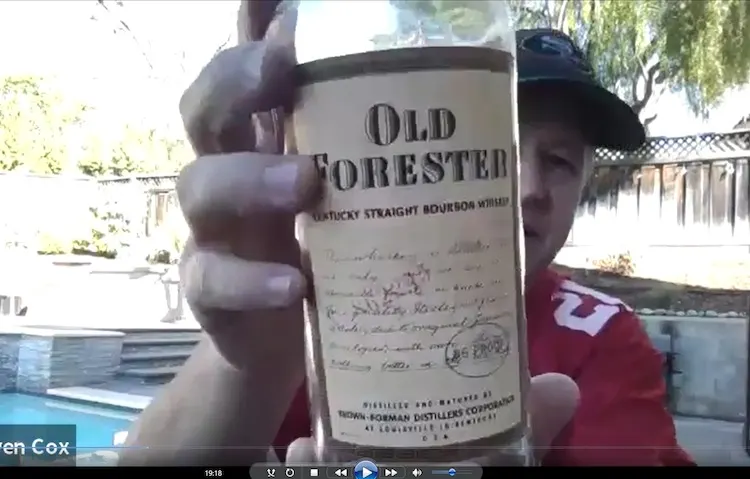
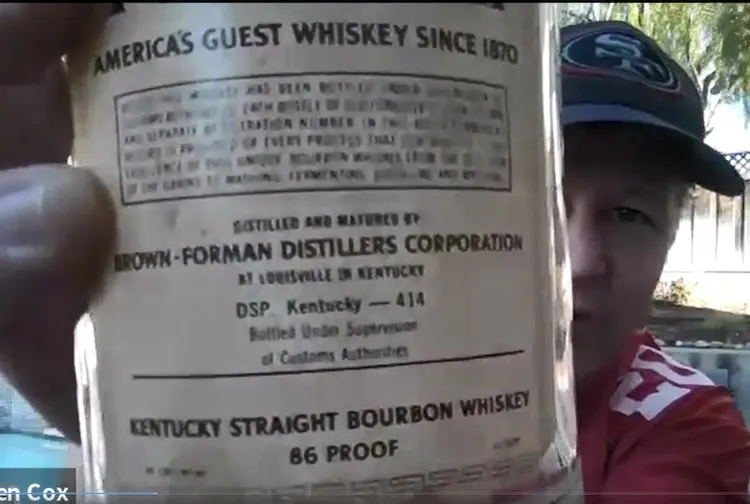
Next up on our dusty samples is a bottle of Old Forester that was exported to Germany in the 1980’s. It wears a “DSP-KY-414” on the label as well as the words “Distilled and Bottled at Brown Forman.” Steve holds up a similar bottle of Old Forester in front of the camera that shows it is an Italian Import but does not list the DSP for it.
For those of you who aren’t aware of the history of Brown Forman having two different DSP’s, here is the quick rundown. Brown Forman had a 36″ diameter column still at their old Louisville location which was known as DSP-KY-414.
They distilled primarily Old Forester distillate (72/18/10 mash bill) on it up until the 1980’s when they closed down that location. They disassembled the still and set it back up at the their Early Times Distillery (DSP-KY-354) on the other side of town in Shively, KY.
The ET Distillery already had a larger 42″ diameter column still that was used to make Early Times distillate (79/11/10 mash bill). The two stills were now side-by-side and are used interchangeably, leading to Brown Forman to stop specifying which whiskey comes off of which still. Rumor has it that the larger Early Times still is better at making distillate during the hot summer months than the Old Forester column still was.
Also, as of 2018, Brown Forman has a third column still that they installed at their downtown Louisville visitors center which is 24″ in diameter and carries the DSP-KY-117 designation.
As we sip on it, we notice a kind of funkiness to it that Hunter describes as “like grape must.” Everyone notices how much fruitier this distillate is compared to later Old Forester products that have more butterscotch qualities.
Pim chimes in with how easy it is to drink a bourbon like this because the flavors are captivating and there is almost no burn. He says that when he has a bottle like this at home, he goes through it very quickly. He then tells us that the Must Have Malts facility also has its own bar with tons of dusty bottles that his team and him enjoy.
He says it gets stocked regularly with bottles that they can’t sell for various reasons like broken seals, ripped labels or bottles that they can’t 100% verify have never been opened before. Pim told us the current selection includes Old Charter Decanters, EH Taylor Barrel Proof, Stitzel Weller and Blanton’s from the late 80’s and early 90’s. If heaven has a bar, I imagine it probably looks like the one inside of the MHM headquarters.
We try to get Pim to spill the beans on his secret source in the US who helps him identify dusty bottles. Pim has referenced him a few times already in our Zoom and we can tell this guy has an extensive collection and is older and very influential in the scene.
Pim can only tell us that his source is a huge National Distillers fan and introduced his team to dusties a few years ago by sending them a very large sampler of various dusty labels. He used those bottles to educate them on what they should be looking for and let the taste do the convincing for him.
The MHM team was mainly on the lookout for rare Scotches before, but now they all have a taste for dusty American Bourbon. Unfortunately for us, Pim never revealed just who exactly this American source of information was. So if you’re reading this now, drop me a line in the comments!
Pim shared a story from his team’s expedition to Spain a few years ago where they were looking for anything rare or unique. They came across a store that literally had an untouched pallet of Blanton’s that had been bottled in 1997 and was covered with dust.
He said that they bought them all for 50 Euros a piece and resold them for 95 Euros (he also sheepishly admitted that now we just got a glimpse of his margins/markup rates for bottles). Pim mentioned that this was the probably the last time his team would run into a jackpot like that since everyone seems to have caught on to the whiskey trends.
Another aspect of the job is that the MHM email inbox often gets messages from people all over the words asking about the provenance of a particular bottle or its value. He says one of the more impressive stories was from a man in the United States who found five sets of Chessman in his basement.
At this point, the conversation turns to how many of us enjoy the Chessman since its viewed as a legendary bourbon among enthusiasts.
Steve points out that he would prefer Old Grand Dad 114 Lot 7 over Old Chessman any day of the week. He goes on to say that he actually bought a Lot 7 OGD114 from MHM in the recent past after watching a YouTube video from a reviewer who praised the Lot 7s as THE bourbon to taste in your lifetime.
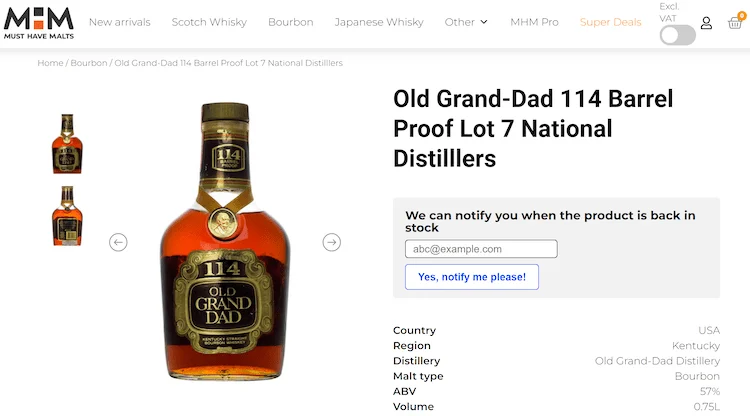
Pim said that he remembers coming into work one morning and noticed that all Lot 7s had been sold throughout the night and that it must have been because of that one video.
We went on to ask him what other whiskies had suddenly vanished overnight like that. He mentioned the Boutique-y Whisky Company’s 24 Year undisclosed pre-fire Bourbon. Many in the group laughed because they were largely responsible for buying most of them up.
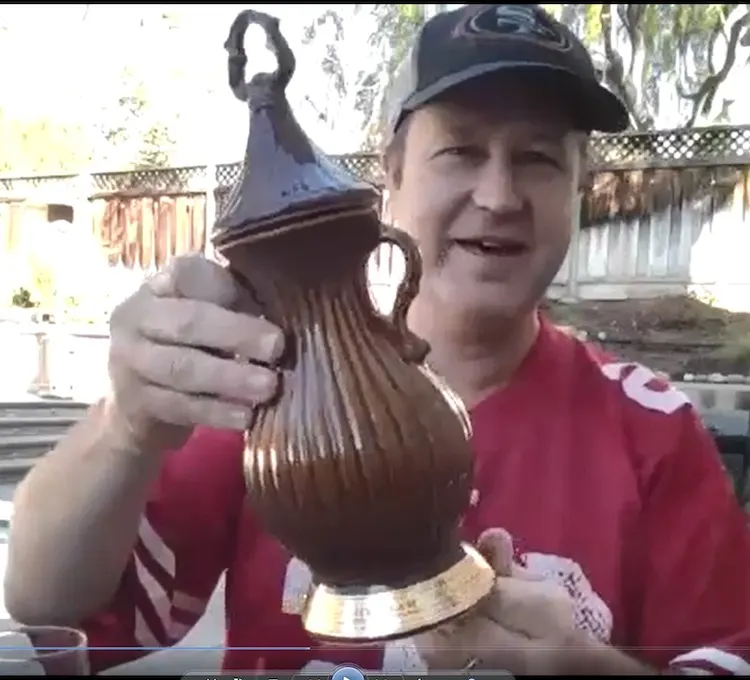
The next bottle up for sampling was a Decanter that looked like an urn. It was a 1979 8 year old Bottled-in-Bond bourbon from Jim Beam. This bottle was interesting because it was 11 years old instead of 8.
The backstory behind it was that the tax strip on the outside shows the date a particular bottle was distilled (this one says “Distilled in 1968” whereas some say that they were distilled as recently as 1971. They were all batched according to BiB laws (meaning there were multiple batches) and used this style of decanter for the 1979 special release (Beam had a special decanter for each year).
As we drank from our samples, there as a split between those of us who really enjoyed the bottle and those that found it to taste “off.” For the ones who liked it, they found a super thick mouthfeel with lots of varnish. Two members weren’t as fond of it saying there was too much weird funk.
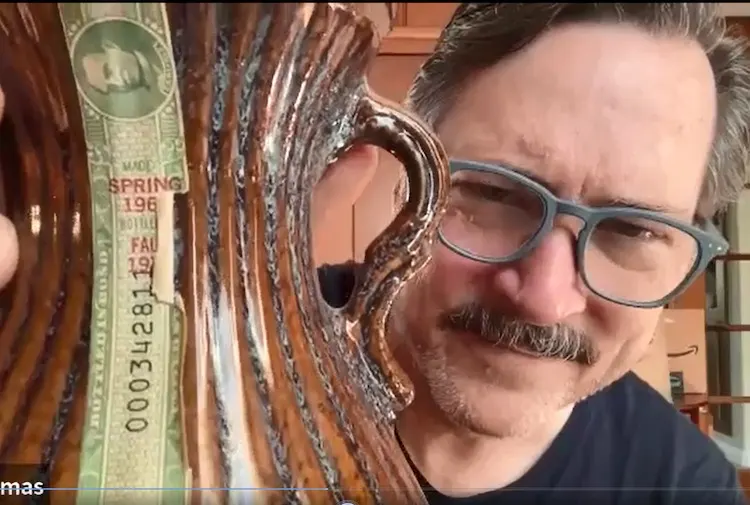
The bottle itself was painted glass and two members of the group that owned one held them up to the camera so the rest of us could see them. One of the guys began to unscrew the top which we found interesting because many of us thought it would be a cork stopper inside.
The decanter even wore a sticker that said “Turn To” with an arrow so that you wouldn’t ruin the threading by trying to pull the top off like a cork.
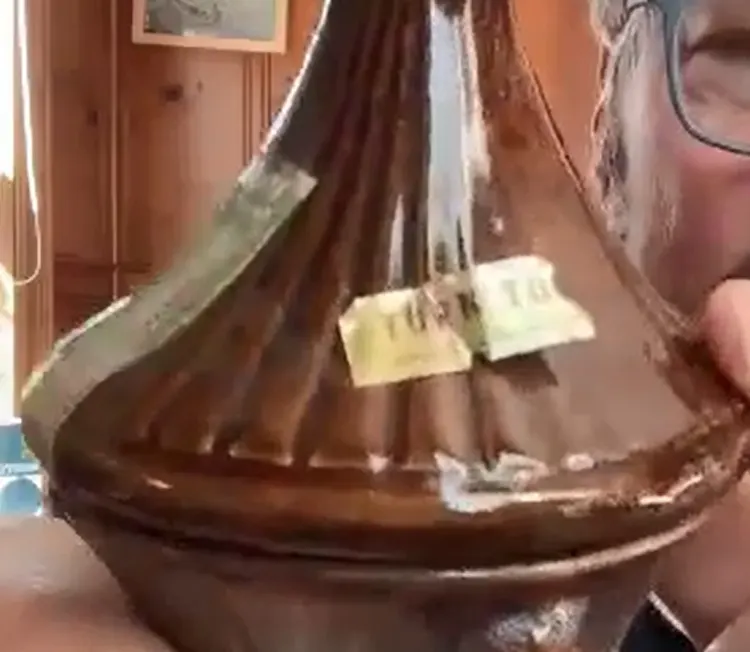
This got the group into discussing the differences in cork qualities that a typical dusty whiskey drinker runs into. In Pim’s experience, he said that Scotch corks from bottles that are half a century old (or older) tend to always hold up very well. But many American whiskey products tend to fall apart.
It’s speculated that a good deal of American products have the inferior “pebbled” corks rather than the more solid one-piece kinds because American producers just didn’t care. One of the members suggests failing corks on dusty bottles have a lot to do with humidity levels that bottles are stored at.
He says that many wine enthusiasts regulate humidity levels for their collections much like cigar enthusiasts would with their humidors. This may make sense why dusty bottle owners in the United States experience so many problems with corks since a majority of homes are air conditioned throughout the year.
European homes are the opposite with many lacking air conditioning. Would this mean that dusty bottles found in Europe have a better chance of having a better cork?
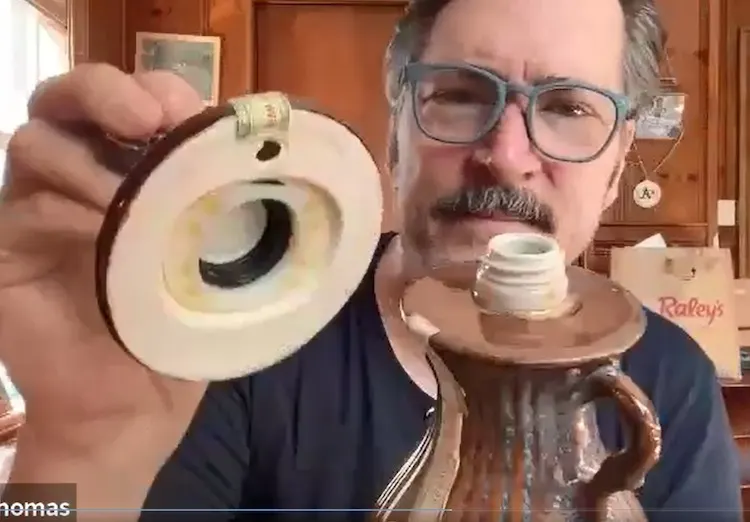
Our final bottle is a 10 year old decanter from JW Dant that comes in at 86 proof and shows a picture with American military personnel on the front. It was bottled to honor the 50th Anniversary of the founding of the American Legion.
Steve mentioned how these older dusties start to get tainted from exposure to cork particles falling down inside or get oxidized when the cork loses its seal.
He braces us for an off taste that he describes as a touch of “soap” and also a little bit metallic. A majority of the group find that the bourbon inside comes off as a bit flat and aren’t that impressed with it. This goes to show the finnicky nature of dusties. Not all will be good and some have to have a lot of the right visual signs to ensure the liquid inside isn’t tainted.
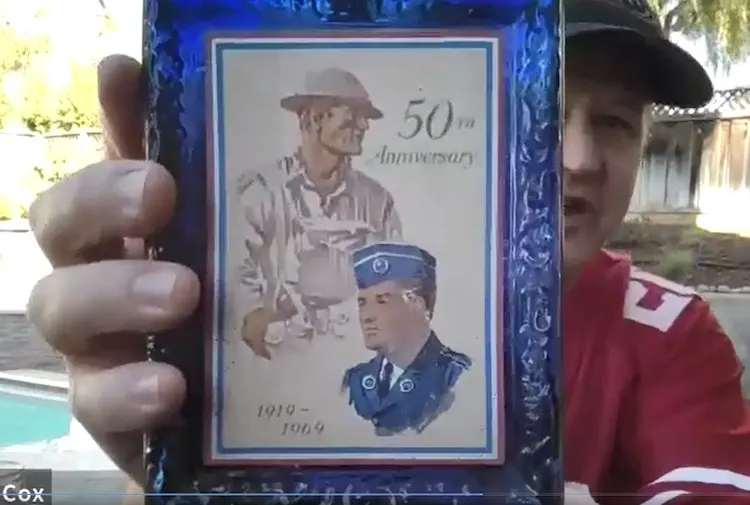
The conversation enters its final leg where we pepper Pim with questions that don’t revolve around dusty bourbons. The first one is “what is his favorite non-Scottish/Irish whiskey from Europe?” His answer surprises us because it is from a local (to him) distillery we have never heard of: Zuidam. They make a whisky in the Netherlands called Millstone which uses ex-Spanish Sherry casks to mature a portion of the distillate.
He says that it’s very good and they are on track to releasing much older whiskies in the future. Pim also tells us about a Norwegian Whisky he likes from the company Aurora Spirits Distillery called Bivrost that is not only aged in the Arctic Circle, but made there too.
The distillery is working towards a releasing a standard 10 year old bottling, but until then they are releasing limited edition 3-year-old bottlings two times a year. A recent edition resulted in their website’s server crashing due to an unexpectedly large demand.
Where does MHM find its modern bourbon releases?
Since we learned of how MHM’s team sourced their dusty bourbon, we were curious how they obtain all of the the modern-day allocated bourbon listed on the site. Pim said that most of it comes from his team scouring retail stores all across Europe while they travel around looking for dusties. Sometimes these retail stores are right in their own backyard.
Pim told us that he found a store close to the MHM warehouse that only carried about 6 types of bourbons. But when he took a closer look, he found one of them was the 2020 Four Roses Small Batch Limited Edition. The kicker was that it was priced for basically retail.
The owners of the store remarked “we wondered when somebody would buy this, but nobody knows what it is.” Occurrences like this are rare but he says they do happen. Pim also hinted to having some contacts in the United States that he can get some bottles from, but doesn’t offer up any additional information other than saying he compares it to treasure hunting when he lands a new source to buy from.
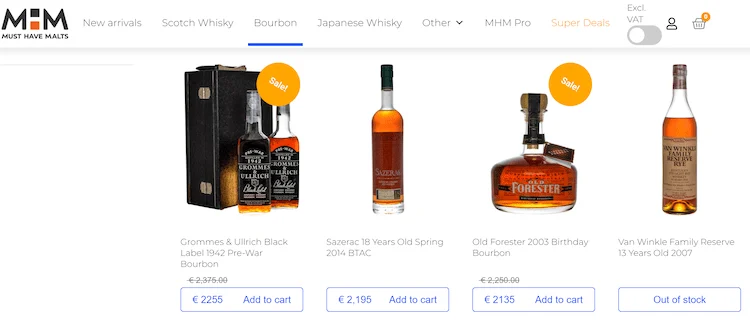
At this point, you may be wondering if MHM uses a distributor at all. We ask Pim and his answer is somewhat murky because first we have to understand that Europe does not have a standard three tier system required by law like we have in the US.
Yes, they have “importers” that retail stores work with to obtain bottles. But just like in the US, demand for highly sought-after whiskey is much higher than supply, so MHM has to play the game just like everyone else and try every technique they can to get an allocation.
Since MHM does not sell the mainstream “shelf whiskeys” that distributors/importers usually base their allocations on, it comes down to MHM relying on the tactics I mentioned before to help stock their warehouse.
Even if MHM had a brick and mortar store that operated like other retailers, the simple math says that the Netherlands is a small market (at about 17 million inhabitants) and won’t receive as many bottles as the UK, Germany or France. This, in turn, leads to smaller allocations from importers and distilleries.
MHM has decided that they won’t dilute their brand by carrying more run-of-the-mill bottles because they know that their clientele come to them for the good stuff. These customers are willing to pay a little bit more to have access to bottles that would’ve taken months or years to find on their own.
Of course MHM gets their cut, but after knowing how their business works and the legwork that their search team puts in to finding these rare bottles, the prices they have seem very fair.
In this day and age, finding new, interesting and great whiskey is getting harder and harder. Everywhere you go to purchase these rare bottles seems to come with a catch.
Either you have to spend all of your money buying normal shelf bottles just to get access to buying a few allocated bottles each year or you’re paying exorbitant prices on the secondary market that is rife with scammers looking to take your money.
And with gas prices at an all time high, simply driving around for hours to different stores adds tens of dollars to the price of a potential bottle you might find. This makes the ease of simply scrolling through the online inventory of Must Have Malts not just a time saver, but a money saver as well. So now that you know about one of the best kept secrets in the industry, what’s in your shopping cart?
Featured Products
- Neat Traveler

- View Larger
- Description:The Aged & Ore Neat Traveler is a complete travel kit for spirits. We combined our widely praised Neat Glass with one of our 3oz Flight Bottles and housed them together in a custom EVA travel case. Perfect for a night away with your favorite pour. The tie
- Bottle Flight

- View Larger
- Description:The Aged & Ore Bottle Flight is a premium set of 4 custom silicone wrapped glass bottles designed to transport and share samples of your favorite spirits. The flight bottles come in a custom EVA travel case that fits perfectly in any small bag. An Aged &
- Travel Bundle
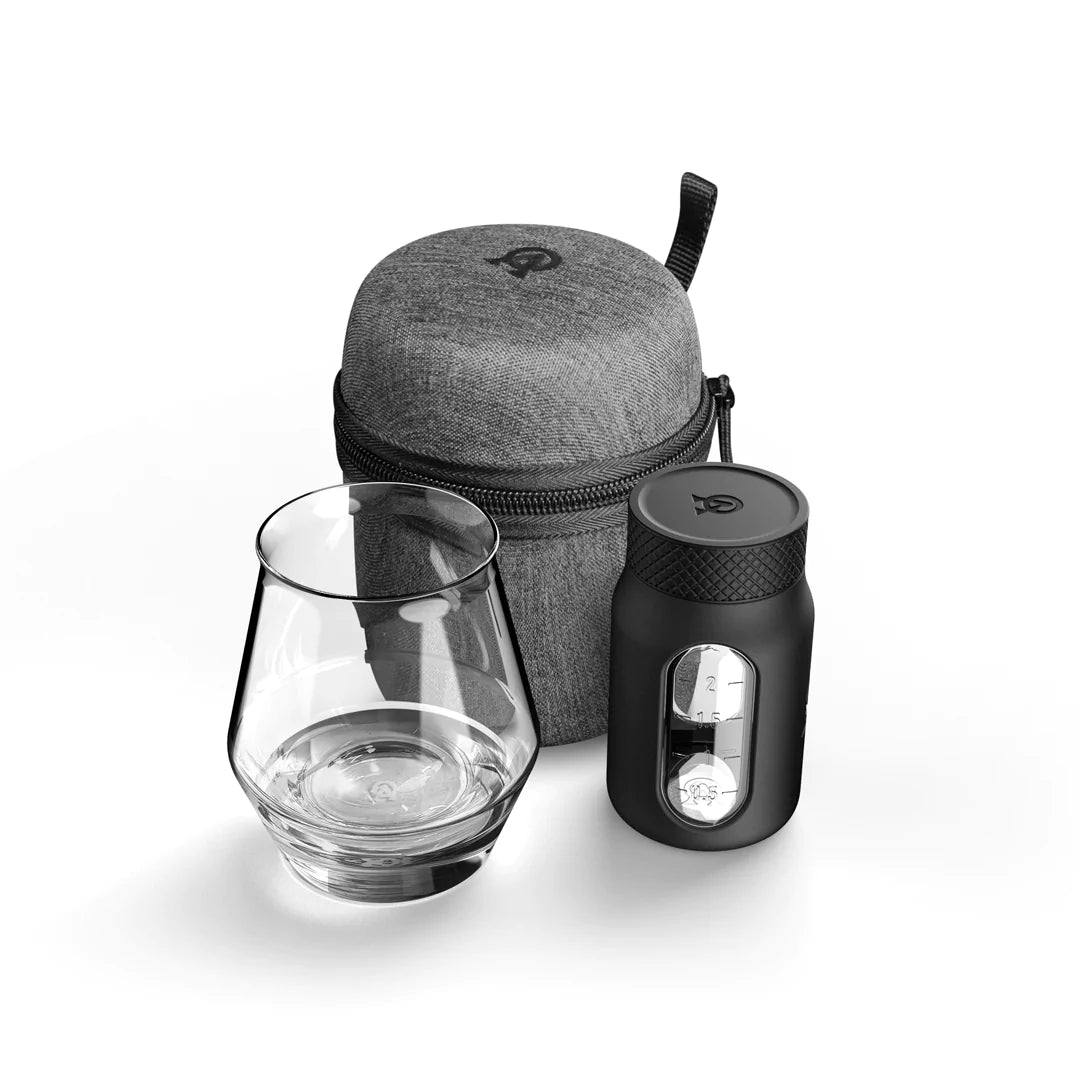
- View Larger
- Description:This Bundle combines two of our crowd favorite products, creating the ultimate travel bundle to bring along your favorite spirits and glassware. Bundle Includes: Neat Traveler (Gray) Bottle Flight (Gray) Note: This bundle is only available in gray and col
*Bourbon Culture is reader-supported. When you buy through links on our site, we may earn an affiliate commission.

